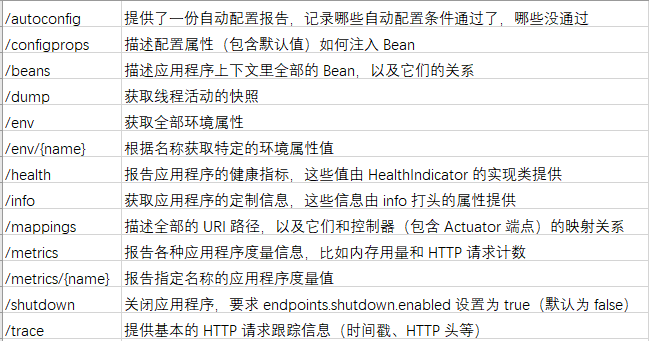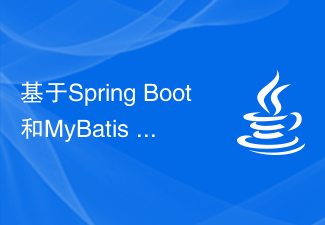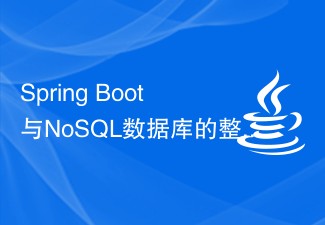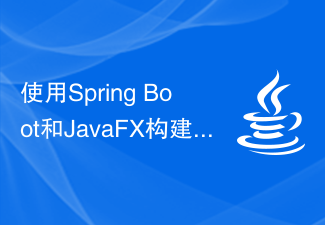 Java
Java javaTutorial
javaTutorial Integration practice of Docker and Spring Boot: optimizing development process and deployment efficiency
Integration practice of Docker and Spring Boot: optimizing development process and deployment efficiency
Integration practice of Docker and Spring Boot: optimizing development process and deployment efficiency
With the rapid development of cloud computing technology, virtualization container technology Docker has become a development and deployment tools. In modern software development, building, packaging, and deploying applications quickly and efficiently is critical. Docker makes this process simple, reliable and repeatable. This article will introduce how to integrate Docker and Spring Boot to optimize the development process and deployment efficiency, and provide specific code examples.
- Introduction to Docker
Docker is a lightweight containerization solution that packages applications and dependencies in an immutable container. This means developers can run the same application in different environments and not be affected by environmental differences. The core concepts of Docker include Image, Container and Repository. Among them, the image is a static snapshot of the application, the container is the instance running the image, and the warehouse is the place where the image is stored and shared.
- Introduction to Spring Boot
Spring Boot is a framework used to simplify Java application development. It provides a way to quickly build standalone, executable, production-grade Spring applications. Spring Boot has features such as automatic configuration, independent deployment, and embedded web servers, allowing developers to easily develop and deploy applications.
- Integration practice of Docker and Spring Boot
3.1. Create a Spring Boot application
First, we need to create a Spring Boot application. This can be configured using Spring Initializr (https://start.spring.io/) or manually via Maven or Gradle. Here we create a simple RESTful API application.
@RestController
@RequestMapping("/api")
public class HelloWorldController {
@GetMapping("/hello")
public String helloWorld() {
return "Hello, Docker and Spring Boot!";
}
}3.2. Writing a Dockerfile
Next, we need to write a Dockerfile to build and package our Spring Boot application. A Dockerfile is a text file that defines a series of steps to build a Docker image.
# 使用maven构建镜像 FROM maven:3.8.4-openjdk-11 AS build WORKDIR /app COPY . . RUN mvn package -DskipTests # 使用adoptopenjdk作为运行时环境 FROM adoptopenjdk:11-jre-hotspot WORKDIR /app COPY --from=build /app/target/demo.jar . EXPOSE 8080 CMD ["java", "-jar", "demo.jar"]
In this Dockerfile, we use Maven to build our application and skip the testing phase. Then, we choose adoptopenjdk as the Java runtime environment. Finally, copy the built jar file into the container and run the application on port 8080.
3.3. Build and run the Docker container
After completing the writing of the Dockerfile, we can use the Docker command to build and run the Docker container.
First, we need to execute the following command in the application root directory to build the Docker image:
docker build -t myapp .
This command will build an image named myapp based on the Dockerfile.
Next, we can use the following command to run our application:
docker run -d -p 8080:8080 myapp
This command will start a container named myapp and map the container's 8080 port to the host's Port 8080.
Now, we can access http://localhost:8080/api/hello in the browser and see the "Hello, Docker and Spring Boot!" information returned by our application.
- Deploy to the cloud platform
After integrating Docker and Spring Boot, we can easily deploy the application to the cloud platform. The following is sample code for deploying to Docker Hub and Kubernetes:
4.1. Deploying to Docker Hub
First, we need to log in to Docker Hub and push our image to the Docker Hub repository .
docker login docker tag myapp username/myapp docker push username/myapp
In this way, our image is pushed to Docker Hub and can be used on any machine that supports Docker.
4.2. Deploying to Kubernetes
Next, we can use Kubernetes to deploy our application. Here, we need to create a Deployment and a Service to manage our application.
First, we need to write a deployment.yaml file with the following content:
apiVersion: apps/v1
kind: Deployment
metadata:
name: myapp-deployment
spec:
replicas: 3
selector:
matchLabels:
app: myapp
template:
metadata:
labels:
app: myapp
spec:
containers:
- name: myapp
image: username/myapp
ports:
- containerPort: 8080Then, we use the kubectl command to create a Deployment:
kubectl apply -f deployment.yaml
Next, we need to create A service.yaml file with the following content:
apiVersion: v1
kind: Service
metadata:
name: myapp-service
spec:
selector:
app: myapp
ports:
- protocol: TCP
port: 80
targetPort: 8080
type: LoadBalancerFinally, we use the kubectl command to create the Service:
kubectl apply -f service.yaml
In this way, our application is deployed to the Kubernetes cluster and can be Service’s external IP access.
- Summary
This article introduces how to integrate Docker and Spring Boot to optimize the development process and deployment efficiency. By packaging applications into Docker containers, we can build and deploy applications quickly and reliably. At the same time, we also demonstrated how to deploy the application to the cloud platform to better manage and scale our application.
By using the integrated practice of Docker and Spring Boot, developers can focus on the implementation of business logic without caring about the underlying environment configuration and deployment details. This not only improves development efficiency, but also improves application portability and scalability. Therefore, applying Docker and Spring Boot to software development has become a fairly common choice.
The above is the detailed content of Integration practice of Docker and Spring Boot: optimizing development process and deployment efficiency. For more information, please follow other related articles on the PHP Chinese website!
 Spring Boot Actuator从未授权访问到getshell的示例分析May 23, 2023 am 08:56 AM
Spring Boot Actuator从未授权访问到getshell的示例分析May 23, 2023 am 08:56 AM前言部门大佬在某src上挖到了这个漏洞,是一个比较老的洞了,我觉得有点意思,就动手在本地搭了个环境测试一下。Actuator是springboot提供的用来对应用系统进行自省和监控的功能模块,借助于Actuator开发者可以很方便地对应用系统某些监控指标进行查看、统计等。在Actuator启用的情况下,如果没有做好相关权限控制,非法用户可通过访问默认的执行器端点(endpoints)来获取应用系统中的监控信息,从而导致信息泄露甚至服务器被接管的事件发生。如上所示,actuator是springb
 如何利用Spring Boot构建区块链应用和智能合约Jun 22, 2023 am 09:33 AM
如何利用Spring Boot构建区块链应用和智能合约Jun 22, 2023 am 09:33 AM随着比特币等数字货币的兴起,区块链技术也逐渐成为热门话题。而智能合约,则可视为区块链技术的重要组成部分。SpringBoot作为一种流行的Java后端开发框架,也能够用来构建区块链应用和智能合约。本文将介绍如何利用SpringBoot搭建基于区块链技术的应用和智能合约。一、SpringBoot与区块链首先,我们需要了解一些与区块链相关的基本概念。区块链
 基于Spring Boot和MyBatis Plus实现ORM映射Jun 22, 2023 pm 09:27 PM
基于Spring Boot和MyBatis Plus实现ORM映射Jun 22, 2023 pm 09:27 PM在Javaweb应用开发过程中,ORM(Object-RelationalMapping)映射技术用来将数据库中的关系型数据映射到Java对象中,方便开发者进行数据访问和操作。SpringBoot作为目前最流行的Javaweb开发框架之一,已经提供了集成MyBatis的方式,而MyBatisPlus则是在MyBatis的基础上扩展的一种ORM框架。
 使用Spring Boot和Apache ServiceMix构建ESB系统Jun 22, 2023 pm 12:30 PM
使用Spring Boot和Apache ServiceMix构建ESB系统Jun 22, 2023 pm 12:30 PM随着现代企业越来越依赖于各种不同的应用程序和系统,企业集成变得愈发重要。企业服务总线(ESB)就是一种集成架构模式,通过将不同系统和应用程序连接在一起,提供通用的数据交换和消息路由服务,从而实现企业级应用程序集成。使用SpringBoot和ApacheServiceMix,我们可以轻松构建一个ESB系统,这篇文章将介绍如何实现。SpringBoot和A
 基于Spring Boot的分布式数据缓存和存储系统Jun 22, 2023 am 09:48 AM
基于Spring Boot的分布式数据缓存和存储系统Jun 22, 2023 am 09:48 AM随着互联网的不断发展和普及,数据的处理和存储需求也越来越大,如何高效且可靠地处理和存储数据成为了业界和研究人员的热门话题。基于SpringBoot的分布式数据缓存和存储系统是近年来备受关注的一种解决方案。什么是分布式数据缓存和存储系统?分布式数据缓存和存储系统是指通过多个节点(服务器)分布式地存储数据,提高了数据的安全性和可靠性,同时也可以提升数据的处理性
 Spring Boot与NoSQL数据库的整合使用Jun 22, 2023 pm 10:34 PM
Spring Boot与NoSQL数据库的整合使用Jun 22, 2023 pm 10:34 PM随着互联网的发展,大数据分析和实时信息处理成为了企业的一个重要需求。为了满足这样的需求,传统的关系型数据库已经不再满足业务和技术发展的需要。相反,使用NoSQL数据库已经成为了一个重要的选择。在这篇文章中,我们将讨论SpringBoot与NoSQL数据库的整合使用,以实现现代应用程序的开发和部署。什么是NoSQL数据库?NoSQL是notonlySQL
 使用Spring Boot和JavaFX构建桌面应用程序Jun 22, 2023 am 10:55 AM
使用Spring Boot和JavaFX构建桌面应用程序Jun 22, 2023 am 10:55 AM随着技术的不断发展,我们现在可以使用不同的技术来构建桌面应用程序。而SpringBoot和JavaFX则是现在较为流行的选择之一。本文将重点介绍如何使用这两个框架来构建一个功能丰富的桌面应用程序。一、介绍SpringBoot和JavaFXSpringBoot是一个基于Spring框架的快速开发框架。它可以帮助开发者快速构建Web应用程序,同时提供一组开
 Spring Boot的任务调度和定时任务实现方法Jun 22, 2023 pm 11:58 PM
Spring Boot的任务调度和定时任务实现方法Jun 22, 2023 pm 11:58 PMSpringBoot是一款非常流行的Java开发框架,不仅具有快速开发的优势,而且还内置了很多实用的功能,其中,任务调度和定时任务就是其常用的功能之一。本文将探讨SpringBoot的任务调度和定时任务实现方法。一、SpringBoot任务调度简介SpringBoot任务调度(TaskScheduling)是指在特定的时间点或某个条件下,执行一些特


Hot AI Tools

Undresser.AI Undress
AI-powered app for creating realistic nude photos

AI Clothes Remover
Online AI tool for removing clothes from photos.

Undress AI Tool
Undress images for free

Clothoff.io
AI clothes remover

AI Hentai Generator
Generate AI Hentai for free.

Hot Article

Hot Tools

Atom editor mac version download
The most popular open source editor

mPDF
mPDF is a PHP library that can generate PDF files from UTF-8 encoded HTML. The original author, Ian Back, wrote mPDF to output PDF files "on the fly" from his website and handle different languages. It is slower than original scripts like HTML2FPDF and produces larger files when using Unicode fonts, but supports CSS styles etc. and has a lot of enhancements. Supports almost all languages, including RTL (Arabic and Hebrew) and CJK (Chinese, Japanese and Korean). Supports nested block-level elements (such as P, DIV),

SublimeText3 Linux new version
SublimeText3 Linux latest version

VSCode Windows 64-bit Download
A free and powerful IDE editor launched by Microsoft

ZendStudio 13.5.1 Mac
Powerful PHP integrated development environment





